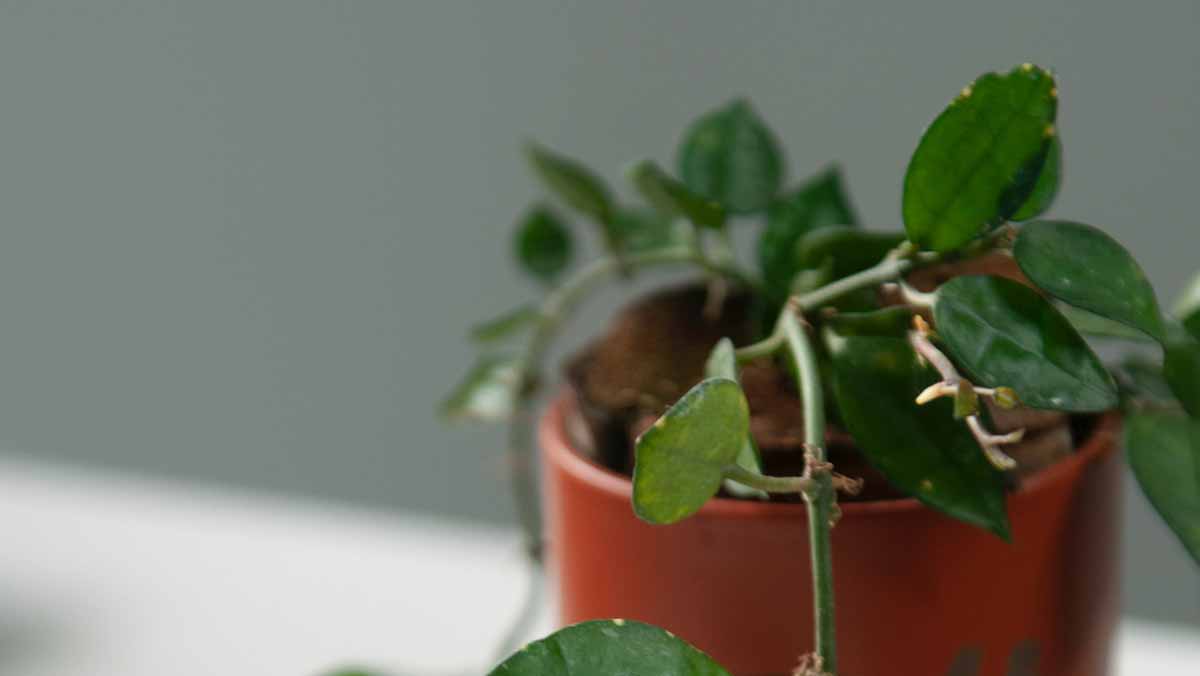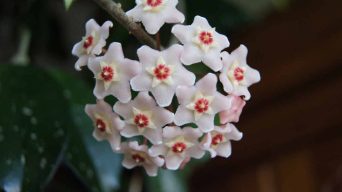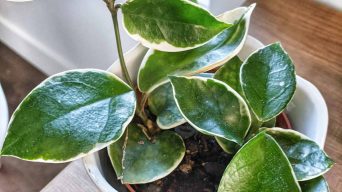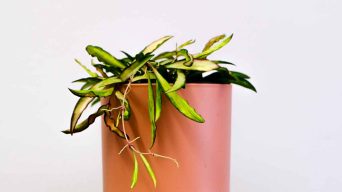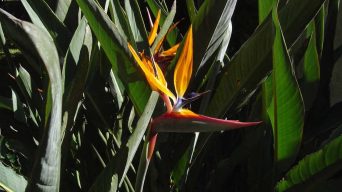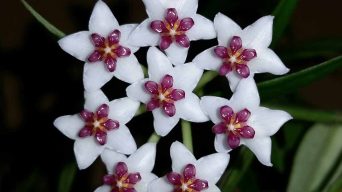Hoya plants are beautiful, easy-to-care-for houseplants.
They are known for their stunning, fragrant flowers and large, glossy leaves.
However, sometimes hoya plants can develop black spots on their leaves.
There are several reasons why black spots may form on hoya leaves.
To help you troubleshoot, we’ve put together a list of the five most common causes of black spots on hoya leaves and some solutions.
What Causes Black Spots on Hoya Leaves and How Can You Fix It?
There are a few different reasons that black spots might form on the leaves of your hoya plant.
The most common causes are overwatering, fungal diseases, and pests.
Most of these problems can be solved with some simple changes to your plant care routine.
Bue is essential to identify the cause of the black spots on your hoya leaves so that you can take the appropriate steps to fix the problem.
Here are 5 potential causes of black spots on hoya leaves and what you can do to solve each problem:
1. Overwatering
Overwatering is a common problem among gardeners, especially beginners.
It is caused by watering your plants too often or giving them too much water at each watering.
It also occurs if the potting mix is too dense or if the pot does not have proper drainage.
This causes the roots to become waterlogged and unable to access the oxygen they need to function.
Overwatering can lead to several problems, including yellowing leaves, wilting, root rot, and eventually death.
In some cases, overwatering can also lead to fungal diseases, which can cause black spots on the leaves.
When the soil is too wet, it provides an ideal environment for fungi to thrive.
The fungi then release spores into the air, which can land on the leaves and cause black spots.
How To Treat an Overwatered Hoya Plant
If you think your Hoya plant is overwatered, you should first stop watering it.
Allow the soil to dry out completely before watering again.
Prune away any yellow or dead leaves, and remove the plant from its pot.
Check the roots for signs of rot, such as blackening or mushiness.
Trim away damaged roots and replant the hoya in a fresh well-draining potting mix.
Do not water the plant again until the soil is dry to the touch.
2. Fungal Diseases
Fungal diseases are another common problem that can cause black spots on hoya leaves.
Several fungi cause black spots on hoya leaves, including black spot fungus, sooty mold, leaf spot, and anthracnose.
Black Spot Fungus
Black spot (Diplocarpon rosae) is a fungus that causes black spots on hoya leaves.
This fungus appears as small, dark spots on the plant’s leaves.
The spots eventually grow and coalesce, causing the leaves to turn yellow and drop off.
Black spot is most commonly found on Hoya plants grown in humid or wet conditions.
The fungus thrives in moist environments and can spread rapidly under ideal conditions.
To prevent black spot fungus, it is essential to water your hoya plants at the base of the plant rather than wetting the leaves.
This will help reduce humidity around the plant and make it less favorable for the fungus to grow.
How To Treat Black Spot Fungus
If your plant is already infected with black spot fungus, you must take immediate action to treat the problem.
Start by pruning away any affected leaves and disposing of them.
Be sure to sterilize your pruning tools before and after use to prevent the spread of the fungus.
You can treat the plant with a natural fungicide, such as neem oil.
This oil is derived from the neem tree and is effective against various fungal diseases.
It can be applied directly to the leaves of the plant, or you can add it to the potting soil around the base of the plant.
Sooty Mold
Sooty mold is a type of fungus that forms a black coating on the leaves of plants.
It is often found on hoya plants infested with aphids or scale insects.
These pests secrete a sticky substance known as honeydew, which the sooty mold fungus feeds on.
The fungus then grows and covers the plant’s leaves, causing them to turn black.
In addition to being unsightly, sooty mold can also interfere with the plant’s ability to photosynthesize.
How To Treat Sooty Mold
The best way to treat sooty mold is to control the aphids or scale insects that are infesting your plant.
Remove any pests you see with your hands or a cotton swab dipped in rubbing alcohol.
You can also treat the plant with an insecticide, such as neem oil or horticultural oil.
Be sure to follow the instructions on the label carefully to avoid harming your plant.
You also need to prune away any leaves covered with sooty mold.
Dispose of the infected leaves to prevent the fungus from spreading.
Fungal Leaf Spot
Leaf spot is another type of fungi that can cause black spots on hoya leaves.
This fungus is usually caused by too much moisture on the leaves and can spread quickly if not treated.
Leaf spot is a fungal disease that can affect a wide variety of plants, from trees and shrubs to annuals and perennials.
While the symptoms of leaf spot vary depending on the type of plant affected, they typically include small, dark spots on the leaves.
In severe cases, the leaves may turn yellow or brown and drop off prematurely.
If left untreated, leaf spot can cause significant damage to plants and may even lead to death.
How To Treat Leaf Spot
If you suspect that your plant has leaf spot, it is crucial to take action immediately.
Start by pruning away any affected leaves and disposing of them.
Be sure to sterilize your pruning tools before and after use to prevent the spread of the fungus.
You can then treat the plant with a fungicide, such as neem oil or horticultural oil.
Be sure to follow the instructions on the label carefully to avoid harming your plant.
You should also ensure that you are watering your plants at the base of the plant rather than wetting the leaves.
This will help reduce the humidity around the plant and make it less favorable for the fungus to grow.
Anthracnose
Anthracnose is a type of fungal disease that can affect a wide variety of plants, including hoya.
The fungi responsible for anthracnose can live in the soil or on the surface of plant leaves and stems.
They typically enter plants through wounds or natural openings, such as stomata.
Once inside the plant, the fungi begin to grow and produce spores.
These spores can then spread to other parts of the plant or other plants, causing new infections. Anthracnose often manifests as small, dark lesions on plants.
The lesions may eventually cause the leaves to wilt, curl, and drop off. In severe cases, anthracnose can kill the entire plant.
How To Treat Anthracnose
If you suspect your plant has anthracnose, it is vital to take action immediately.
The first step is to remove any affected leaves from the plant, as these can spread the disease.
Once done, you should disinfect your scissors or pruning tool with rubbing alcohol to prevent the disease from spreading.
It is also important to improve air circulation around the plant. This can be done by moving it to a brighter location or increasing the air circulation in the room.
You should also ensure that you are not overwatering your plant, as this can create favorable conditions for the disease to spread.
It is also important to water your plant from the bottom up so the leaves do not get wet.
If the problem persists, you may need to use a natural fungicide, such as neem oil.
To prevent anthracnose from occurring in the first place, choosing a plant that is resistant to the disease is essential.
When buying a hoya plant, look for one with healthy leaves and no disease signs.
You should also avoid overcrowding your plants, as this can reduce air circulation and make it more difficult for the plant to fight off disease.
3. Bacterial Infection
Bacterial infections are another possible cause of black spots on hoya leaves.
Some of the most common bacterial diseases affecting hoya plants include bacterial leaf spot and bacterial blight.
Bacterial Leaf Spot
Bacterial leaf spot is a disease that affects the leaves of hoya plants.
The disease is caused by a bacterium called Xanthomonas campestris pv. vitians, which infects leaves and stems through open wounds.
Once infected, leaves develop small spots that quickly expand and turn brown or black.
In severe cases, the entire leaf may turn brown and wither away.
The disease is spread by water, wind, and tools, and it can survive in plant debris for long periods.
To prevent the spread of bacterial leaf spot, it is essential to practice good hygiene in the garden, such as using clean tools and disposing of infected plant material immediately.
How To Treat Bacterial Leaf Spot
If you think your plant has bacterial leaf spot, it is important to take action immediately.
The first step is to remove any affected leaves from the plant.
You should also disinfect your scissors or pruning tool with rubbing alcohol to prevent the disease from spreading.
It is also important to increase air circulation around the plant and ensure you are not overwatering it.
If the problem persists, you may need to use a copper-based fungicide or bactericide.
Bacterial Blight
Bacterial blight is another disease that can affect hoya plants and cause black spots on their leaves.
The disease is caused by a bacterium called Pseudomonas syringae pv. syringae, which infects the leaves and stems of plants through open wounds.
Once infected, the leaves develop small water-soaked spots that quickly turn brown or black.
A yellow halo often surrounds the spots, and the leaves may eventually drop off the plant.
To prevent bacterial blight, sterilize your gardening tools before each use and avoid wounding the plant.
How To Treat Bacterial Blight
If you think your hoya has bacterial blight, the best action is to remove and dispose of any affected leaves.
Sanitize your gardening tools and avoid wounding the plant to prevent the spread of the disease.
You can also try using a copper-based fungicide to help control the bacteria.
Always follow the instructions on the label carefully, as too much copper can be toxic to plants.
You can also try treating the plant with a homemade solution of 1 tablespoon of baking soda and 1 quart of water.
Once a week, apply the solution to the affected leaves with a soft cloth.
4. Viral Infection
Another possible cause of black spots on hoya leaves is a viral infection.
Many different types of viruses can affect hoya plants, including tobacco mosaic virus, cucumber mosaic virus, and impatiens necrotic spot virus.
These viruses are spread by insects, such as aphids and whiteflies, and contaminated gardening tools can also spread them.
Symptoms of a viral infection include black spots on the leaves, stunted growth, yellowing leaves, and deformities.
To prevent the spread of viruses, it is important to practice good hygiene in the garden and avoid handling plants when you are sick.
You should also inspect your plants regularly for signs of insects and remove them promptly.
How To Treat A Viral Infection
Unfortunately, there is no cure for a viral infection.
The best action is to remove the affected plant from your garden to prevent the virus from spreading.
You should also disinfect your gardening tools with rubbing alcohol or bleach to prevent the spread of the disease.
5. Pests
One final possible cause of black spots on hoya leaves is pests.
Aphids, scale insects, and mealybugs are common pests that can infest hoya plants and cause black spots on their leaves.
These pests suck the sap from the leaves, leading to yellowing, stunted growth, and eventually, black spots.
Aphids
Aphids are small, pear-shaped insects that can be black, brown, green, or white.
They are often found in clusters on the stems and leaves of plants and can reproduce quickly.
Aphids secrete a sticky substance called honeydew, which can attract other pests and cause sooty mold to grow on the plant.
Scale Insects
Scale insects are tiny, hard-bodied pests that can be brown, black, or white.
They are often found on the stems and leaves of plants, where they suck the sap.
Scale insects can also secrete honeydew, which can attract other pests and cause sooty mold to grow on the plant.
Mealybugs
Mealybugs are small, oval-shaped insects covered in a white, waxy substance.
They feed on the sap of plants, which can cause stunted growth, wilting, and leaf drop.
Mealybugs can also secrete honeydew, which attracts other pests and can cause sooty mold to grow on the plant.
How To Treat Pests
If you think your hoya plant has pests, removing them by hand is the best course of action. With a soft cloth, gently wipe the pests from the plant.
You can also try using a forceful stream of water to dislodge them from the plant.
If the infestation is severe, you can use a natural insecticide, such as neem oil.
Always follow the instructions on the label carefully, as too much insecticide can harm plants.
You can also try making a homemade insecticide by mixing 1 tablespoon of dish soap with 1 quart of water.
Spray the solution on the affected plant, being sure to cover the underside of the leaves.
Repeat this treatment every few days until the pests are gone.
How To Prevent Black Spots on Hoya Leaves
The best way to prevent black spots on hoya leaves is to practice good gardening hygiene and provide the plant with proper care.
Some of the things you can do to prevent black spots on hoya leaves include:
- Sanitize your gardening tools before using them on your hoya plant. This will help prevent spreading diseases or pests that could cause black spots on the leaves.
- Avoid overhead watering of your hoya plant. Water that splashes up on the leaves can spread diseases and promote fungal growth, both of which can cause black spots.
- Provide adequate air circulation around your hoya plant. Good air circulation helps to prevent fungal growth and the spread of diseases.
- Inspect your hoya plant regularly for signs of pests or disease. If you notice any black spots on the leaves, remove them immediately.
- Keep the area around your hoya plant clean and free of debris. This will help to prevent the spread of diseases and pests.
- Provide your hoya plant with the proper care. This includes planting it in well-draining soil, placing it in an area that receives bright indirect light, and watering it when the soil is dry to the touch.
Following these simple tips can help prevent black spots on hoya leaves.
Final Thoughts
Various things, including diseases, fungi, pests, and improper care, can cause black spots on hoya plant leaves.
Taking simple preventative measures and being vigilant about inspecting your plant can help prevent black spots on hoya leaves.
If you notice black spots on the leaves of your hoya plant, take immediate action to remove the cause and treat the plant.
With proper care and attention, your hoya plant will soon be again healthy and vigorous.

